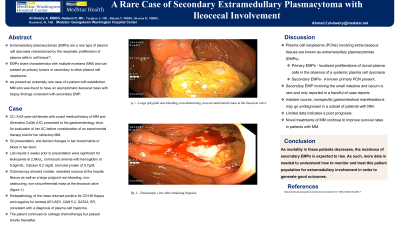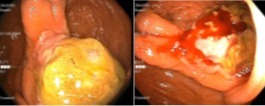Back


Poster Session D - Tuesday Morning
Category: Colon
D0126 - A Rare Case of Secondary Extramedullary Plasmacytoma With Ileocecal Involvement
Tuesday, October 25, 2022
10:00 AM – 12:00 PM ET
Location: Crown Ballroom

Has Audio

Ahmad Al-Dwairy, MD
Medstar Georgetown/Washington Hospital Center
Washington DC, DC
Presenting Author(s)
Ahmad Al-Dwairy, MD1, Danial Nadeem, MD2, Tarek W. Bakain, MD2, Jobin Varghese, MD3, Disha Sharma, MD4, Manish Bastakoti, MD2
1Medstar Georgetown/Washington Hospital Center, Washington, DC; 2Medstar Washington Hospital Center, Washington, DC; 3Washington Hospital Center, Washington, DC; 4Medstar- Georgetown Washington Hospital Center, Washington, DC
Introduction: Extramedullary plasmacytomas (EMPs) are a rare type of plasma cell dyscrasia characterized by the neoplastic proliferation of plasma cells in soft tissue.EMPs share characteristics with multiple myeloma (MM) and can present as primary tumors or secondary to other plasma cell neoplasms.Herein we present an extremely rare case of a patient with established MM who was found to have an asymptomatic ileocecal mass with biopsy findings consistent with secondary EMP.
Case Description/Methods: A 62-year-old female with a past medical history of MM and Ulcerative Colitis (UC) presented to the gastroenterology clinic for evaluation of her UC before consideration of an experimental therapy trial for her refractory MM.On presentation, she denied changes in her bowel habits or blood in her stool. Lab results two weeks prior to presentation were significant for leukopenia at 2.9k/uL, normocytic anemia with hemoglobin at 8.5gm/dL, Calcium 8.2 mg/dl, and total protein of 5.7g/dl. Colonoscopy showed nodular, ulcerated mucosa at the hepatic flexure as well as a large polypoid non-bleeding, non-obstructing, non-circumferential mass at the ileocecal valve. Histopathology of the mass returned positive for CD138 Kappa and negative for lambda AE1/AE3, CAM 5.2, GATA3, ER, consistent with a diagnosis of plasma cell myeloma. The patient continued on salvage chemotherapy but passed shortly thereafter.
Discussion: Plasma cell neoplasms (PCNs) involving extra-osseous tissues are known as extramedullary plasmacytomas (EMPs).EMPs are further classified into primary EMPs, which are localized proliferation of clonal plasma cells in the absence of a systemic plasma cell dyscrasia, and secondary EMPs, where there is already a known primary PCN present. To the best of our knowledge, secondary EMP involving the small intestine and cecum is rare and only reported in a handful of case reports.
Due to the indolent course of EMPs, nonspecific gastrointestinal manifestations may go undiagnosed in a subset of patients with MM. The prognosis of secondary EMP involving the gastrointestinal tract remains unclear, however, the limited data we have indicates a poor prognosis.On the other hand, novel treatments of MM continue to improve survival rates in patients with MM. As mortality in these patients decreases, the incidence of secondary EMPs is expected to proportionately rise as well. As such, more data is needed to understand how to monitor and treat this patient population for extramedullary involvement in order to generate good outcomes

Disclosures:
Ahmad Al-Dwairy, MD1, Danial Nadeem, MD2, Tarek W. Bakain, MD2, Jobin Varghese, MD3, Disha Sharma, MD4, Manish Bastakoti, MD2. D0126 - A Rare Case of Secondary Extramedullary Plasmacytoma With Ileocecal Involvement, ACG 2022 Annual Scientific Meeting Abstracts. Charlotte, NC: American College of Gastroenterology.
1Medstar Georgetown/Washington Hospital Center, Washington, DC; 2Medstar Washington Hospital Center, Washington, DC; 3Washington Hospital Center, Washington, DC; 4Medstar- Georgetown Washington Hospital Center, Washington, DC
Introduction: Extramedullary plasmacytomas (EMPs) are a rare type of plasma cell dyscrasia characterized by the neoplastic proliferation of plasma cells in soft tissue.EMPs share characteristics with multiple myeloma (MM) and can present as primary tumors or secondary to other plasma cell neoplasms.Herein we present an extremely rare case of a patient with established MM who was found to have an asymptomatic ileocecal mass with biopsy findings consistent with secondary EMP.
Case Description/Methods: A 62-year-old female with a past medical history of MM and Ulcerative Colitis (UC) presented to the gastroenterology clinic for evaluation of her UC before consideration of an experimental therapy trial for her refractory MM.On presentation, she denied changes in her bowel habits or blood in her stool. Lab results two weeks prior to presentation were significant for leukopenia at 2.9k/uL, normocytic anemia with hemoglobin at 8.5gm/dL, Calcium 8.2 mg/dl, and total protein of 5.7g/dl. Colonoscopy showed nodular, ulcerated mucosa at the hepatic flexure as well as a large polypoid non-bleeding, non-obstructing, non-circumferential mass at the ileocecal valve. Histopathology of the mass returned positive for CD138 Kappa and negative for lambda AE1/AE3, CAM 5.2, GATA3, ER, consistent with a diagnosis of plasma cell myeloma. The patient continued on salvage chemotherapy but passed shortly thereafter.
Discussion: Plasma cell neoplasms (PCNs) involving extra-osseous tissues are known as extramedullary plasmacytomas (EMPs).EMPs are further classified into primary EMPs, which are localized proliferation of clonal plasma cells in the absence of a systemic plasma cell dyscrasia, and secondary EMPs, where there is already a known primary PCN present. To the best of our knowledge, secondary EMP involving the small intestine and cecum is rare and only reported in a handful of case reports.
Due to the indolent course of EMPs, nonspecific gastrointestinal manifestations may go undiagnosed in a subset of patients with MM. The prognosis of secondary EMP involving the gastrointestinal tract remains unclear, however, the limited data we have indicates a poor prognosis.On the other hand, novel treatments of MM continue to improve survival rates in patients with MM. As mortality in these patients decreases, the incidence of secondary EMPs is expected to proportionately rise as well. As such, more data is needed to understand how to monitor and treat this patient population for extramedullary involvement in order to generate good outcomes

Figure: Large polypoid non-bleeding, non-obstructing, non-circumferential mass at the ileocecal valve before and after biopsy.
Disclosures:
Ahmad Al-Dwairy indicated no relevant financial relationships.
Danial Nadeem indicated no relevant financial relationships.
Tarek Bakain indicated no relevant financial relationships.
Jobin Varghese indicated no relevant financial relationships.
Disha Sharma indicated no relevant financial relationships.
Manish Bastakoti indicated no relevant financial relationships.
Ahmad Al-Dwairy, MD1, Danial Nadeem, MD2, Tarek W. Bakain, MD2, Jobin Varghese, MD3, Disha Sharma, MD4, Manish Bastakoti, MD2. D0126 - A Rare Case of Secondary Extramedullary Plasmacytoma With Ileocecal Involvement, ACG 2022 Annual Scientific Meeting Abstracts. Charlotte, NC: American College of Gastroenterology.
